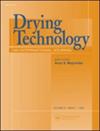Effect of cold atmospheric pressure plasma pretreatment on the drying kinetics, physicochemical properties and selected bioactive compounds of okra pods subjected to hot air impingement drying
IF 2.7
3区 工程技术
Q3 ENGINEERING, CHEMICAL
引用次数: 1
Abstract
Abstract This study aimed to evaluate the effect of cold atmospheric pressure plasma pretreatment (CP) on the drying kinetics, physicochemical properties, content of chlorophylls (alpha and beta), lycopene, phenolic compounds and antioxidant capacity of hot air impingement dried (HAID) okra pods. CP treatment significantly increased moisture diffusivity from 3.04 x 10−9 to 5.07 x 10−9 m2/s and decreased the HAID time by 38%, i.e., from 235 to 145 min. CP resulted in a reduction of alpha chlorophyll and lycopene contents, whereas the combination of CP and HAID allowed both chlorophylls to be preserved. The HPLC-MS/MS analysis revealed that CP-treated samples showed lower content of phenolic compounds, while combination of CP for 15 s and HAID provided excellent preservation of these compounds. The results show that the combination of the advanced CP treatment and HAID method was useful to obtain optimal results for both drying kinetics and the quality of okra pods.冷常压等离子体预处理对热空气冲击干燥秋葵豆荚干燥动力学、理化性质及部分生物活性物质的影响
本文章由计算机程序翻译,如有差异,请以英文原文为准。
求助全文
约1分钟内获得全文
求助全文
来源期刊

Drying Technology
工程技术-工程:化工
CiteScore
7.40
自引率
15.20%
发文量
133
审稿时长
2 months
期刊介绍:
Drying Technology explores the science and technology, and the engineering aspects of drying, dewatering, and related topics.
Articles in this multi-disciplinary journal cover the following themes:
-Fundamental and applied aspects of dryers in diverse industrial sectors-
Mathematical modeling of drying and dryers-
Computer modeling of transport processes in multi-phase systems-
Material science aspects of drying-
Transport phenomena in porous media-
Design, scale-up, control and off-design analysis of dryers-
Energy, environmental, safety and techno-economic aspects-
Quality parameters in drying operations-
Pre- and post-drying operations-
Novel drying technologies.
This peer-reviewed journal provides an archival reference for scientists, engineers, and technologists in all industrial sectors and academia concerned with any aspect of thermal or nonthermal dehydration and allied operations.
 求助内容:
求助内容: 应助结果提醒方式:
应助结果提醒方式:


